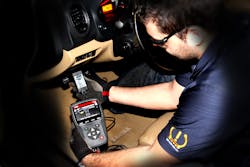TPMS has been mandated on production vehicles sold in the U.S. since 2008. As this technology is somewhat new and the process to educate your customers may be challenging, we will focus this article on both how to inform and prepare your customers about potential issues of the system, and how to integrate maintenance and repair of TPMS into your shop.
First, let’s discuss what your customers know about TPMS: very little. They may know that there is a light on the dash indicating an issue if it arises, but most likely their understanding stops there. According to various studies, as many as 60 percent of drivers do not know what the indicator light means if it comes on.
Determine the TPMS system type
Due to customer unawareness, it is your job as a service provider to educate your customer as to both what the system does and what is necessary to maintain, and if required, repair the system.
When describing the system, it may not be a bad idea to make yourself aware of the type of system that is specific to that customer’s car. The two most common systems are a “direct” and “indirect” measuring system. Understanding the two systems is important so you are able to communicate with your customer, but also to make sure you are using the proper tools and test methods for repair and maintenance.
Direct testing consists of a set of sensors, either a band or stem type, installed on each wheel. In most cases there also will be an antenna mounted close to the sensors on the body or embedded in a window. The antenna is necessary because the sensors emit a RF (Radio Frequency) signal to transmit not only their status, but a unique identification number to a control module.
Tools necessary to diagnose, maintain and repair this type of system consist of a dedicated TPMS programming/activation tool from companies like Bartec, ATEQ, K-Tool and OTC to name a few, as well as a scan tool. Some additional tools required include an inch-pound torque wrench, valve core torquing tool and, if necessary, specific tools to remove valve cores if they are damaged.
Indirect systems mostly utilize the ABS (Antilock Braking System) or ESC (Electronic Stability Control) systems to monitor wheel speeds in order to determine if any tire is low. Measuring the wheel speed to determine if tire pressure is low is much less expensive for the vehicle manufacturer to implement, but it is less accurate and will not indicate specifically which tire is low. This system uses “inferred logic” to determine if tire pressure is low by measuring a wheel’s speed and comparing it to others on the same vehicle. This system assumes that all wheels are the same diameter and if they are properly inflated, they will move at the same speed. If a tire is underinflated, it will move at a slower speed than the others because the rolling diameter is less.
The tools required to diagnose, test and maintain this system are a bi-directional scan tool, a DMM and possibly a lab scope.
After you understand the differences in monitoring systems, it is time to find out which type of system is on your customer’s vehicle. The ways to determine this are; the owner’s manual, verified repair information such as Alldata or Mitchell; or the specification/instruction sheet from your dedicated TPMS tool. Believe it or not, the owner’s manual can provide some unique information specific to that particular vehicle. For instance a Mazda CX5 uses a typical warning light to warn if it has detected a low pressure on a tire, but it also can display a “check tire pressure” message on the information center. Looking at a repair information source instead of the owner’s manual may lead you to think the displayed message is indicating a low tire, when in fact it really is a user -defined maintenance reminder to check the tire pressures at a specific time-based interval.
Once it has been determined what type of system is on the vehicle it is possible to decide which tools and what strategy will be necessary to diagnose or repair the system.
First off, just setting the tire pressures may be the answer. Some vehicles require you to let the car set for 15 minutes prior to adjusting and resetting the system to allow for temperatures on each tire to stabilize. Temperatures can cause a variance because pressure increases when tires are warm, and decreases as they cool. Stabilizing the temperatures will allow for inconsistencies to stabilize when a tire is running a little warmer than the others because the pressure is a little low, keeping them all the same when they are inflated to the proper pressure.
Let’s now discuss the tools required for testing or programming of both systems if just a tire pressure reset did not cure the issue. Since the most common system is the direct type, we’ll look at that first.
Working on direct TPMS systems
Tools used:
- Tire pressure gauge
- Scan tool
- TPMS tool (ATEQ, Bartec, K-Tool, OTC, etc.)
- Inch-pound torque wrench
- Valve core torquing tool
- Tire sensor repair tool kits (Sunex, OTC, Ken-Tool)
When you are testing a direct system you need to use a tire pressure gauge that is both accurate and consistent. You also will need to make sure you are adjusting the tire pressure on the vehicle to the recommended tire pressure stated by the vehicle manufacturer, typically posted on the information placard on the driver’s door or door pillar.
Once the tire pressures are correct, follow the vehicle manufacturer’s recommended procedure to program the individual sensors to report their location on the vehicle properly. In most cases you will need to use the dedicated TPMS tool to activate the sensor in order for it to relay its position on the car. Also most vehicles require that the sensors are triggered in a specific order such as Left Front, Right Front, Right Rear and Left Rear; and that the programming process is completed within a short timeframe. If the process is not completed in the correct timeframe (on some cars as little as two minutes), you will need to start the entire process over again. If a sensor requires replacement it will be necessary to identify the new sensor to the TPMS module by programming the sensors unique serial number into the system. This is necessary because each sensor needs an identifying signal in order to communicate its information to the specific location on a specific vehicle.
Being as the sensors use radio frequency signals to communicate, it is necessary to have a specific identifier transmitted on each sensor. In many cases a dedicated TPMS tool will have the ability to not only trigger the communication process, but will have the capability of entering identifying information from a new sensor to the TPMS module. On other vehicles, it is possible to use your scan tool to enter sensor information to the module.
Normal maintenance on a TPMS system consists of assuring tire pressures are correct and that valve caps are clean and installed tightly. Corrosion can occur on valve stems on TPMS sensors just as easily as it can on a regular tire valve stem. The big difference is that if the corrosion causes damage to the valve core you will need to replace it without damaging a relatively expensive sensor. There are a few companies such as Sunex, OTC and Ken-Tool that have sensor repair tool kits (see Fig. xx) that include a removal tool and a cleaning tool to make sure the threads are clean and will seal a new valve core.
You also must be aware that if it is necessary to replace a valve core on a sensor, you need to use a nickel-plated rather than a copper valve core to prevent corrosion due to electrolysis. Use your valve core torquing tool and tighten the valve core to the proper specification in order to prevent either a leak from being loose, or damage to the sensor from over-tightening.
If it is necessary to perform a service requiring removal of the tire from the rim, it is necessary to remove it in a manner that will not damage a TPMS sensor.
(See the sidebar for information on the correct tire/sensor removal procedure.)
Working on Indirect TPMS systems
Tools used:
- Tire pressure gauge
- Technical Service Bulletins (TSBs)
- Bi-directional scan tool
- Digital multimeter (DMM)
- Lab scope
Indirect TPMS systems require a different routine for diagnosis if there is a fault. It is necessary to first check tire pressures with this system also. It is also necessary to check service information on this system to make sure there are no current TSBs requiring a specific repair, such as a pattern failure grounding issue, or other service procedure the manufacturer has found as a consistent issue.
In many cases a manufacturer will change the algorithm the ABS module uses to determine if there is a low tire. If this is the case on your customer’s vehicle, it will require a reprogram of the ABS or ESC system with either a manufacturer-specific scan tool, or a J2534 programming tool.
If there are repeated problems of a warning light coming on, you will need to use your scan tool to determine if any fault codes are present in the ABS or ESC systems. Fault codes will need to be addressed prior to doing any other service or testing. It also may be necessary to test individual wheel speed sensors with either your DMM in an AC voltage mode, or use a lab scope to observe the pattern the sensor displays to see if any glitches exist.
There have been reports of ABS sensors that have been damaged by placing a magnetic dial indicator too close to the sensor when using the dial indicator to test brake rotor run-out. We also have had an instance or two where another shop has sent a vehicle to us to diagnose a TPMS issue. In every instance, we found that during an axle or brake service the other shop replaced a rotor, axle or hub that did not have a tone ring installed and since it was missing, the wheel speed sensor signal would not be triggered.
As with all new technologies, using the correct information to understand the system, as well as the process to repair it and the right tools, will allow you to make an effective and efficient repair.


